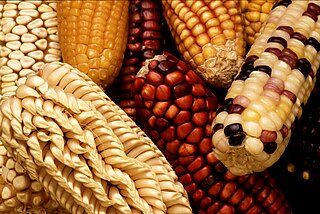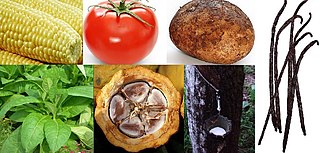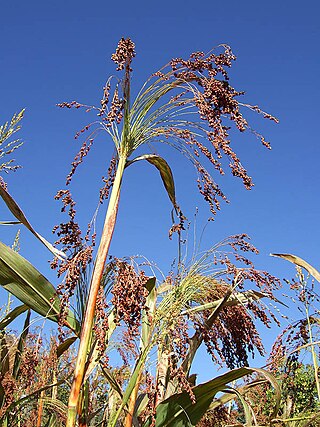
Wheat is a grass widely cultivated for its seed, a cereal grain that is a worldwide staple food. The many species of wheat together make up the genus Triticum ; the most widely grown is common wheat. The archaeological record suggests that wheat was first cultivated in the regions of the Fertile Crescent around 9600 BCE. Botanically, the wheat kernel is a type of fruit called a caryopsis.

Millets are a highly varied group of small-seeded grasses, widely grown around the world as cereal crops or grains for fodder and human food. Most species generally referred to as millets belong to the tribe Paniceae, but some millets also belong to various other taxa.

Eleusine coracana, or finger millet, also known as ragi in India, kodo in Nepal, is an annual herbaceous plant widely grown as a cereal crop in the arid and semiarid areas in Africa and Asia. It is a tetraploid and self-pollinating species probably evolved from its wild relative Eleusine africana.

Sorghum or broomcorn is a genus of about 25 species of flowering plants in the grass family (Poaceae). Some of these species are grown as cereals for human consumption and some in pastures for animals. One species is grown for grain, while many others are used as fodder plants, either cultivated in warm climates worldwide or naturalized in pasture lands.

Domestication is a sustained multi-generational relationship in which humans assume a significant degree of control over the reproduction and care of another group of organisms to secure a more predictable supply of resources from that group. A broader biological definition is that it is a coevolutionary process that arises from a mutualism, in which one species constructs an environment where it actively manages both the survival and reproduction of another species in order to provide the former with resources and/or services. The domestication of plants and animals by humans was a major cultural innovation ranked in importance with the conquest of fire, the manufacturing of tools, and the development of verbal language.

The cowpea is an annual herbaceous legume from the genus Vigna. Its tolerance for sandy soil and low rainfall have made it an important crop in the semiarid regions across Africa and Asia. It requires very few inputs, as the plant's root nodules are able to fix atmospheric nitrogen, making it a valuable crop for resource-poor farmers and well-suited to intercropping with other crops. The whole plant is used as forage for animals, with its use as cattle feed likely responsible for its name.

Agricultural biodiversity or agrobiodiversity is a subset of general biodiversity pertaining to agriculture. It can be defined as "the variety and variability of animals, plants and micro-organisms at the genetic, species and ecosystem levels that sustain the ecosystem structures, functions and processes in and around production systems, and that provide food and non-food agricultural products.” It is managed by farmers, pastoralists, fishers and forest dwellers, agrobiodiversity provides stability, adaptability and resilience and constitutes a key element of the livelihood strategies of rural communities throughout the world. Agrobiodiversity is central to sustainable food systems and sustainable diets. The use of agricultural biodiversity can contribute to food security, nutrition security, and livelihood security, and it is critical for climate adaptation and climate mitigation.

Pearl millet is the most widely grown type of millet. It has been grown in Africa and the Indian subcontinent since prehistoric times. The center of diversity, and suggested area of domestication, for the crop is in the Sahel zone of West Africa. Recent archaeobotanical research has confirmed the presence of domesticated pearl millet on the Sahel zone of northern Mali between 2500 and 2000 BC. 2023 is the International Year of Millets, declared by the United Nations General Assembly in 2021.

Sorghum × drummondii, is a hybrid-derived species of grass raised for forage and grain, native to tropical and subtropical regions of Eastern Africa. It may also be known as Sorghum bicolor × Sorghum arundinaceum after its parents. Some authorities consider all three species to be subspecies under S. bicolor.

Agriculture began independently in different parts of the globe, and included a diverse range of taxa. At least eleven separate regions of the Old and New World were involved as independent centers of origin. The development of agriculture about 12,000 years ago changed the way humans lived. They switched from nomadic hunter-gatherer lifestyles to permanent settlements and farming.

The Crop Trust, officially known as the Global Crop Diversity Trust, is an international nonprofit organization with a secretariat in Bonn, Germany. Its mission is to conserve and make available the world's crop diversity for food security.

Sorghum bicolor, commonly called sorghum and also known as great millet, broomcorn, guinea corn, durra, imphee, jowar, or milo, is a grass species cultivated for its grain, which is used for food for humans, animal feed, and ethanol production. Sorghum originated in Africa, and is now cultivated widely in tropical and subtropical regions. Sorghum is the world's fifth-most important cereal crop after rice, wheat, maize, and barley, with 61,000,000 metric tons of annual global production in 2021. S. bicolor is typically an annual, but some cultivars are perennial. It grows in clumps that may reach over 4 metres (13 ft) high. The grain is small, ranging from 2 to 4 millimetres in diameter. Sweet sorghums are sorghum cultivars that are primarily grown for forage, syrup production, and ethanol; they are taller than those grown for grain.

A crop is a plant that can be grown and harvested extensively for profit or subsistence. When the plants of the same kind are cultivated at one place on a large scale, it is called a crop. Most crops are cultivated in agriculture or hydroponics. Crops may include macroscopic fungus and marine macroalga, some of which are grown in aquaculture.

Commercial sorghum is the cultivation and commercial exploitation of species of grasses within the genus Sorghum. These plants are used for grain, fibre and fodder. The plants are cultivated in warmer climates worldwide. Commercial Sorghum species are native to tropical and subtropical regions of Africa and Asia.

Carpoxylon macrospermum is a species of palm tree endemic to Vanuatu, and the only species in the genus Carpoxylon.

A crop wild relative (CWR) is a wild plant closely related to a domesticated plant. It may be a wild ancestor of the domesticated (cultivated) plant or another closely related taxon.

A center of origin is a geographical area where a group of organisms, either domesticated or wild, first developed its distinctive properties. They are also considered centers of diversity. Centers of origin were first identified in 1924 by Nikolai Vavilov.
Sorghum propinquum is a species of wild Sorghum native to most of tropical Asia, from India to Southeast Asia, southern China, Malesia and Papuasia. A perennial, rhizomatous diploid with the same number of chromosomes (2n=20) as the annual, non-rhizomatous diploid Sorghum bicolor, it is being studied for its potential for sorghum crop improvement. In an ancient hybridization event with S. bicolor, it gave rise to Johnson grass, one of the planet's worst weeds.

Sorghum arundinaceum, the common wild sorghum, is a species of flowering plant in the family Poaceae. It is native to Sub‑Saharan Africa, Madagascar, many of the Indian Ocean islands, and the Indian Subcontinent, and has been introduced to northern South America, the US states of California and Florida, Puerto Rico, Taiwan, New Guinea, and a number of smaller islands worldwide. It is the wild progenitor of cultivated sorghum, Sorghum bicolor, with some authorities considering it to be a mere variety or subspecies; Sorghum bicolor var. arundinaceum, or Sorghum bicolor subsp. verticilliflorum.
Hybridization, when new offspring arise from crosses between individuals of the same or different species, results in the assemblage of diverse genetic material and can act as a stimulus for evolution. Hybrid species are often more vigorous and genetically differed than their ancestors. There are primarily two different forms of hybridization: natural hybridization in an uncontrolled environment, whereas artificial hybridization occurs primarily for the agricultural purposes.















